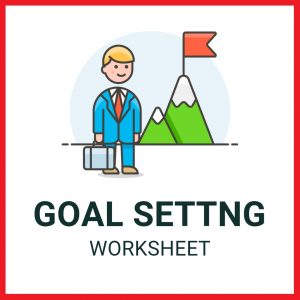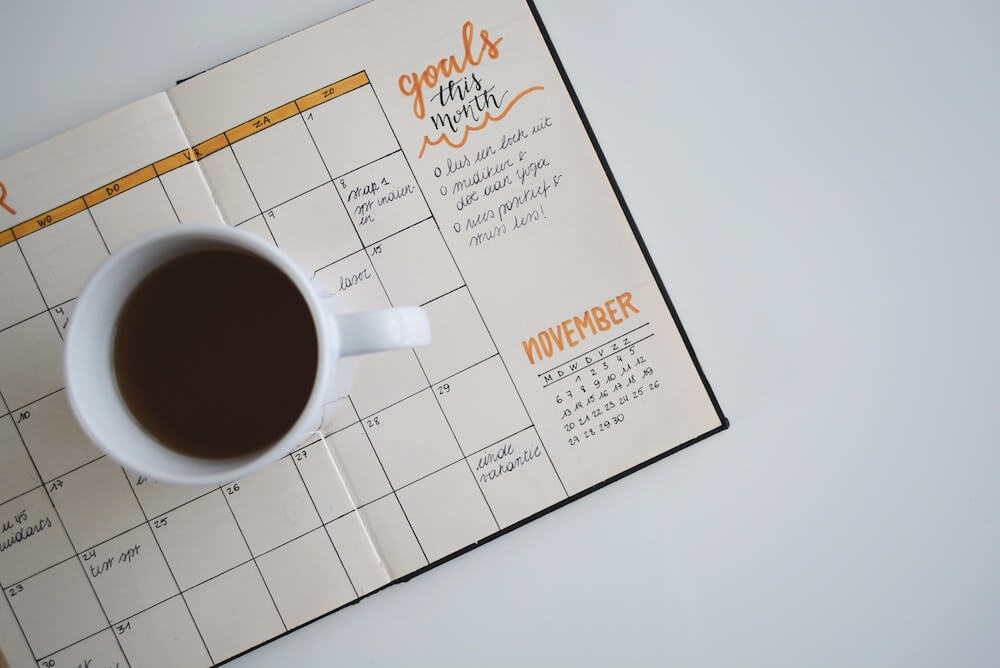
The goal-setting worksheet at the end of this article will save you from ever feeling overwhelmed with things to do.
When you look back at the end of a year and it seems like you’ve been treading water instead of moving forward, there’s a reason for that.
The goals you set are too far in the future, too big, and too important to keep putting off.
I’ll show you how to avoid the pitfalls that prevent you from reaching your goals.
To get to the finish line, change the way you set inspiring big-picture goals.
Instead of the long slog of a marathon, start thinking of your work as a series of short, intense sprints.
This framework works no matter what you’re trying to accomplish.
Do you want to start working on your online business idea? Perfect, let’s do it.
Would you like to read business books in 2025? Cool, this framework is for you.
Originally published on January 30th, 2019, this article was updated and republished on September 30th, 2024.
What Is Goal Setting and How Can it Help Your Business?
Goal setting is the process of identifying what you really want in the long-term, and then mapping out an action plan to get there.
Great goal setting doesn’t just try to get you from A to B. It takes you from A to Z. Your action plan should break your overarching goal down into small, achievable steps. This makes it easier to maintain motivation, reduces overwhelm, and keeps you moving in the right direction.
Goal setting is invaluable in all areas of life.
We all have hopes, dreams, and ideas. The only difference between the dreamers and the doers is that the doers turned their grand visions into actionable goals. They commit to doing the work to achieve them.
For businesses, goal setting is especially imperative.
Here’s why.
Provides Direction and Focus
Whether you’ve got a hundred employees or a business of one, setting clear goals will help you maintain focus and direction on what truly matters.
Without defined goals, losing sight of what’s important is easy. You–or your people–will generate idea after idea or follow tangent after tangent. It might feel like you’re making progress. But you’re just treading water because you’re not moving toward your most important goal.
For example, say your overarching goal is to get 100 repeat clients by the end of the year. If you haven’t articulated that to your team, they won’t know where to focus.
Instead of putting their energy into sales and customer success, they may spend too much time on website design or product development–prohibiting you and your business from hitting your goal.
Employee Motivation
Another significant benefit of business goal setting is its effect on employee motivation. As humans, we’re innately designed to seek out opportunities for growth, fulfillment, and success.
Goal setting plays into this psyche. They give us an endpoint, a purpose, a mission.
That’s not to say you’ll share your annual business goal with your team and leave it at that. Great leaders break down their goal and uncover the role each person in their team will play in reaching it.
That way, each person understands their potential to impact the business’ success positively.
Performance Measurement
When you give each member of your team their own set of goals, you also unlock access to a crucial tool: performance measurement.
Essentially, each of your people’s workplace goals can become a benchmark for measuring progress and performance. It’s an indicator that shows you how well they’re doing, how reasonable their goals are, and how you may need to adjust your strategy.
Accountability
If you’ve ever tried going on a diet, you’ll know that regularly weighing yourself is an important part of the process. Why? Accountability. When you step on the scale each week, you’re holding yourself accountable for your eating habits the week before.
The same goes with business goal setting. The goals you’ve given each of your team members are the proverbial scale. If they’ve hit their target, great! If they haven’t, you’ll need to find out what’s going on, and either help them refocus or reassess how achievable the goal you’ve set is.
Resource Allocation
All business leaders know that there’s always more you could be doing. More marketing, more sales, more team bonding, more networking…
The trouble is, all of us only have a finite amount of hours in the day.
Thankfully, you can use goal setting to allocate resources effectively.
Instead of getting overwhelmed by a humongous to-do list, look at your business’ strategic goals. You can then prioritize you and your team’s tasks based on what really needs to be done–and save the rest for another time.
Strategic Planning
Goal setting is the bedrock of strategic planning. Once you know where you want to get to, you can map out how to get there.
To do that, though, you need to make sure you’ve got the right kind of goals in place.
Here are some common pitfalls I see aspiring entrepreneurs run into as they set their business goals.
Your Goals May Be Too Long-Term
If last year was going to be the year that you finally launched a side hustle, what happened? And why aren’t you watching the sales roll in right now?
The reason could be that you gave yourself way too much time to get distracted and lose motivation.
The problem with making year-long goals is there is too much time for distractions to get in your way.
At the beginning of the year, it seems as if there is plenty of time to get serious, leaving you wide open to procrastinate.

When you get distracted by the inevitable things that come up, your business goals will get put on the back burner, because there is always time to catch up later.
Unfortunately, later comes with its own time commitments and distractions, just like now.
Over the course of a year, your life, your business, and possibly your entire industry could be radically different than they are now. Things change fast and your ideas could become irrelevant if you take too long to follow through.
If you have an inspiring goal this year, to learn how to make money online or how to become a freelancer, or finally take it to the next level, you might need a long time to get there. Or maybe you simply want to create and sell an online course.
So how can a short-term goal setting worksheet help you plan for the big things you want to do?
Your Goal Setting May Be Too Big
Huge goals are huge. This is an obvious but important point to let sink in. This is a subtle yet crucial mindset shift.
Starting a business from scratch takes an enormous amount of effort, some business hacks, and consistent daily action.
When you have too much work piled up between you and your goal of becoming an entrepreneur, it is very easy to get discouraged.

The urge to give yourself a break is no match for your willpower once defeatism has set in.
I would never tell you to tone down the scope of your aspirations.
Your big dreams are the fuel that ignites your passion, and you need them. So dream big!
But just for a minute, let’s think small.
Before you make your first million dollars in sales, you need to make your first hundred.
Before you get your hundredth customer, you need to find your first one.
And what do you need before that? You probably need to test out an idea, get a website, and start building an audience.
Each of those could be goals to set for yourself in shorter timeframes.
Instead of setting a huge, non-specific goal to “start a successful business,” make a series of smaller goals. Each of these is the right scope for a short-term goal setting worksheet:
- Validate your business idea
- Create a website for your new business
- Make your first sale
Breaking down your big goal into smaller parts makes it easier to see where you are going, what you need to do next, and how to accomplish your goal. And you can see that each small goal builds on the next, leading to the ultimate big win.
If you do some careful planning up front, you will give your dreams a much higher chance of becoming reality.
Enter the 12-week sprint.
Why Working in 12-Week Sprints Is Better Than a Year-Long Marathon
12 weeks, approximately three months is a perfect amount of time to schedule for serious work on your goals. Where will you be in 90 days?
A 12-week sprint is long enough to allow for the inevitable distractions that will come up but short enough to keep you pushing towards your deadline, with the end always in sight. There’s a new theory of distractions that could give you a better understanding on how your brain functions.
Twelve weeks may not be long enough to achieve earth-shattering results, but it is long enough to make huge strides toward them.
 Work in months, not years, and you will be able to keep your intensity up.
Work in months, not years, and you will be able to keep your intensity up.
You won’t lose motivation because you will have an end goal in close range. When you get to the finish line, the satisfaction of getting done what you set out to do will be so rewarding that you’ll be ready to start your next sprint with renewed energy.
Plus, you’ll have a built-in reward if you do it right.
Never Miss Your Deadlines: Take Small Steps Towards Big Rewards
If for some reason, you had to eat a whole loaf of bread in the next ten minutes, how would you do it?
First, you’d want it in slices. Then you’d take one bite a time, out of each slice. Achieving your big goals is best done the same way, one bite at a time.
Start by breaking down your big goal into broad phases. Choose a point in the journey that is reasonable and doable in 12 weeks.
For example, if you are starting from scratch, you could use three cycles of the goal setting worksheet to set up three sprints:
- Get your website up and running (Here’s a SiteGround review to help you do this right)
- Getting your first customers
- Growing to a specific number of customers or sales
If you are also working a full-time job, be realistic about how much time you can dedicate to your business each day.
Then set yourself a goal of doing as many or a few of these steps as you can. Every day. Weekends included.

If the steps are small enough, you should be able to get at least one thing done every day towards your goal.
What these steps look like could be as small as posting a job on a freelance site to get your logo designed, spending half an hour researching web hosting platforms, or writing the copy for a sales page.
Figure out each new challenge as you approach it, and don’t worry about learning how to do steps 15 or 20 when you are only on step 5. Doing this will keep you from making steady progress.
Finally, make sure you plan for a well-deserved reward when you have reached your target.
Knowing you have a break coming is key to keeping your motivation high throughout the weeks of hard work.
Take a short break to enjoy your success, and then plan your next sprint.
Your Goal Setting Worksheet
If you try a series of sprints instead of a marathon this year, when you look back at the end of 2019, you will accomplish more than you thought possible.
Remember to think short term by planning 12 weeks out, think tiny steps by breaking every step down to the smallest parts, and think of a way to celebrate your progress at the end.
By the time you finish your first sprint, victorious, you will be so excited about your progress you won’t want to stop.
Get the power of 12-week sprints on your side to finally crush your big goals, with a free goal setting worksheet. Download it now!